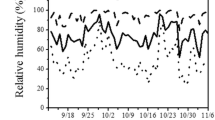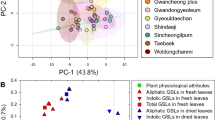Abstract
Total and individual glucosinolate (GSL) content of leaves of vegetable turnip rape (Brassica rapa L. var. rapa) was determined in a set of 45 varieties consisting in early, medium and late types grown at two locations in northwestern Spain. The objectives were to determine the diversity among varieties in GSL content and to relate that variation with earliness and plant habit. Eight GSL were identified, being two aliphatic GSL, gluconapin (84.4 % of the total GSL) and glucobrassicanapin (7.2 % of the total GSL) the most abundant. Indolic and aromatic GSL content were low but also showed significant differences among varieties. Differences in total and individual GSL content were found among varieties, plant habit groups, and earliness groups. Total GSL content ranged from 19 to 37.3 μmol g−1 dw in early and extra-late groups, respectively, and from 19.5 to 36.3 μmol g−1 dw for turnips and turnip greens groups, respectively. These differences were consistent to values found for gluconapin content where the turnip group had the highest values (31.8 μmol g−1 dw) and the turnip top group had the lowest (15.7 μmol g−1 dw). Two varieties, MBG-BRS0429 and MBG-BRS0550 (from turnip greens and extra-late groups) and MBG-BRS0438 (from turnips and late groups), stood out as they had the highest total GSL content and could be used as a good source of these beneficial bioactive compounds. Elucidation of genetic diversity among crops can provide useful information to assist plant breeders to design improved breeding strategies in order to obtain varieties rich on GSL.

Similar content being viewed by others

Abbreviations
- DW:
-
Dry weight
- DAP:
-
Days after planting
- GSL:
-
Glucosinolates
- HPLC:
-
High performance liquid chromatography
References
Zhao JJ, Wang XW, Deng B, Lou P, Wu J, Sun RF, Xu ZY, Vromans J, Koornneef M, Bonnema G (2005) Genetic relationships within Brassica rapa as inferred from AFLP fingerprints. Theor Appl Gen 110:1301–1314
Padilla G, Cartea ME, Velasco P, de Haro A, Ordas A (2007) Variation of glucosinolates in vegetable crops of Brassica rapa. Phytochemistry 68:536–545
van Doorn HE, van der Kruk GC, van Holst GJ, Raaijmakers-Ruijs N, Postma E, Groeneweg B, Jongen WHF (1998) The glucosinolates sinigrin and progoitrin are important determinants for taste preference and bitterness of Brussels sprouts. J Sci Food Agric 78:30–38
Muller R, de Vos M, Sun JY, Sonderby IE, Halkier BA, Wittstock U, Jander G (2010) Differential effects of indole and aliphatic glucosinolates on Lepidopteran herbivores. J Chem Ecol 36:905–913
Halkier BA, Gershenzon J (2006) Biology and biochemistry of glucosinolates. Ann Rev Plant Biol 57:303–333
Beevi SS, Mangamoori LN, Subathra M, Edula JR (2010) Hexane extract of Raphanus sativus L. roots inhibits cell proliferation and induces apoptosis in human cancer cells by modulating genes related to apoptotic pathway. Plant Foods Hum Nutr 65:200–209
Okulicz M (2010) Multidirectional time-dependent effect of sinigrin and allyl isothiocyanate on metabolic parameters in rats. Plant Foods Hum Nutr 65:217–224
Akhlaghi M, Bandy B (2010) Dietary broccoli sprouts protect against myocardial oxidative damage and cell death during ischemia-reperfusion. Plant Foods Hum Nutr 65:193–199
Nastruzzi C, Cortesi R, Esposito E, Menegatti E, Leoni O, Iori R, Palmieri S (1996) In vitro cytotoxic activity of some glucosinolate-derived products generated by myrosinase hydrolysis. J Agric Food Chem 44:1014–1021
Sarikamis G (2009) Glucosinolates in crucifers and their potential effects against cancer: Review. Can J Plant Sci 89:953–959
Smith TK, Lund EK, Clarke RG, Bennett RN, Johnson IT (2005) Effects of Brussels sprout juice on the cell cycle and adhesion of human colorectal carcinoma cells (HT29) in vitro. J Agric Food Chem 53:3895–3901
Brown PD, Tokuhisa JG, Reichelt M, Gershenzon J (2003) Variation of glucosinolate accumulation among different organs and developmental stages of Arabidopsis thaliana. Phytochemistry 62:471–481
Farnham MW, Wilson PE, Stephenson KK, Fahey JW (2004) Genetic and environmental effects on glucosinolate content and chemoprotective potency of broccoli. Plant Breed 123:60–65
Kabouw P, Biere A, van der Putten WH, van Dam NM (2010) Intra-specific differences in root and shoot glucosinolate profiles among white cabbage (Brassica oleracea var. capitata) cultivars. J Agric Food Chem 58:411–417
Zhao J, Wang X, Deng B, Lou P, Wu J, Sun R, Xu Z, Vromans J, Koornneef M, Bonnema G (2005) Genetic relationships within Brassica rapa as inferred from AFLP fingerprints. Theor Appl Gen 110:1301–1314
Cartea ME, Velasco P, Obregon S, Padilla G, de Haro A (2008) Seasonal variation in glucosinolate content in Brassica oleracea crops grown in northwestern Spain. Phytochemistry 69:403–410
Kim SJ, Kawaguchi S, Watanabe Y (2003) Glucosinolates in vegetative tissues and seeds of twelve cultivars of vegetable turnip rape (Brassica rapa L.). Soil Sci Plant Nutr 49:337–346
Yang B, Quiros C (2010) Survey of glucosinolate variation in leaves of Brassica rapa crops. Gen Res Crop Evol 57:1079–1089
Steel RDG, Torrie JH, Dickey DA (1997) Principles and procedures in statistics: a biometrical approach. McGraw Hill, New York
SAS Institute (2007) The SAS system. SAS online doc. HTML format version eight. SAS Institute Inc, Cary
Francisco M, Cartea ME, Soengas P, Velasco P (2011) Effect of genotype and environmental conditions on health-promoting compounds in Brassica rapa. J Agric Food Chem 59:2421–2431
Ciska E, Martyniak-Przybyszewska B, Kozlowska H (2000) Content of glucosinolates in cruciferous vegetables grown at the same site for 2 years under different climatic conditions. J Agric Food Chem 48:2862–2867
Bellostas N, Sorensen JC, Sorensen H (2007) Profiling glucosinolates in vegetative and reproductive tissues of four Brassica species of the U-triangle for their biofumigation potential. J Sci Food Agric 87:1586–1594
Francisco M, Velasco P, Moreno D, Garcia-Viguera C, Cartea M (2010) Cooking methods of Brassica rapa affect the preservation of glucosinolates, phenolics and vitamin C. Food Res Int 43:1455–1463
Acknowledgements
This research was supported by funding from the National Plan for Research and Development (AGL2006-04455 and AGL2009-09922) and Excma. Diputación Provincial de Pontevedra. Authors thank the invaluable help of Rosaura Abilleira and Gloria Fernández for all the laboratory work.
Author information
Authors and Affiliations
Corresponding author
Rights and permissions
About this article
Cite this article
Cartea, M.E., de Haro, A., Obregón, S. et al. Glucosinolate Variation in Leaves of Brassica rapa Crops. Plant Foods Hum Nutr 67, 283–288 (2012). https://doi.org/10.1007/s11130-012-0300-6
Published:
Issue Date:
DOI: https://doi.org/10.1007/s11130-012-0300-6



